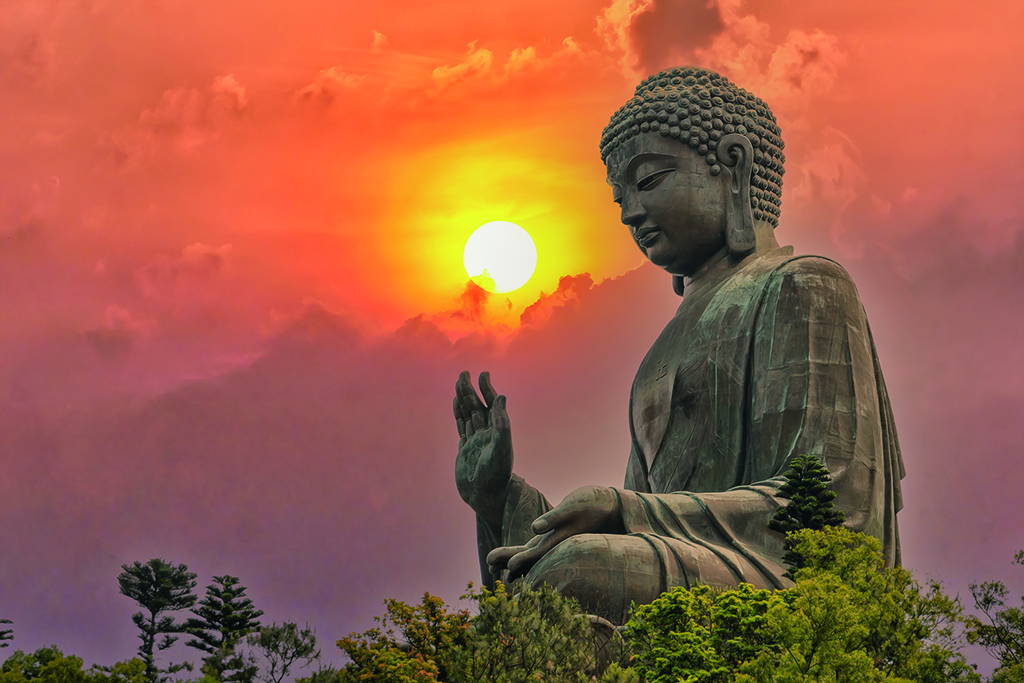Special Topics
Contemplating death with a remembrance of impermanence
 Reflecting on death is not meant to fill us with fear or scare us. The practice of contemplating death and accepting death as part of life can help us reconsider the priorities in our life. When we can prepare ourselves for death in advance; thus, we will not panic or have any regrets when our final moment comes.
Reflecting on death is not meant to fill us with fear or scare us. The practice of contemplating death and accepting death as part of life can help us reconsider the priorities in our life. When we can prepare ourselves for death in advance; thus, we will not panic or have any regrets when our final moment comes.The late Thai master Ajahn Chah once said, "Imagine you go to a fortune teller and he tells you that 'you will die within seven days.' Do you think you can still sleep well? You will definitely let go all things and practice day and night. In fact, we are facing the threat of the death executioner in every instant of our life." However, most people are under the illusion that they still have a lot of time, and tend to think, "I can always wait until tomorrow," "I will wait until when I have time," "I think I will wait until later," "Maybe I will wait until I am retired," to do this or that. By thinking in this way, they have certainly spent a lot of time in vain.
Aging, sickness and death as the heavenly messengers
Contemplating death is a very important Buddhist practice. While the Buddha was still Prince Siddhartha, he had been deeply shocked by the sight of an old person, a sick person, and a corpse at the city gate outside the palace. The image of the corpse in particular reminded him that he and his loved ones would also have to face death someday. This prompted him to renounce his home life in search of the Path, thus eventually attaining the Buddhahood.
In the Devaduta Sutta of the Majjhima Nikaya, or the Middle-length Discourses of the Buddha, the Buddha referred to aging, sickness, and death as the "heavenly messengers (devaduta)". In doing so, he was demonstrating how several phenomena signal these states including: the phenomena of gray hair, weak eyesight, and crooked back characteristic of aging; the distress and pain of illness marked by frailty and weakness, being chronically sick in bed, and the need of being taken care of; and, finally, the reality of death when our physical body perishes, with the break-up and destruction of all of our faculties, to be thrown away in the grave just like rotten wood. They serve as our greatest teachers, revealing to us the very nature of our short and transient life, and warning us that we should wake up and be alert to this truth.
Therefore, practicing mindfulness of death breaks and eliminates our misconception that we can escape death, helping us clearly recognize that our life is actually steadily moving toward its end and, thus, towards death. The practice of cultivating awareness of death and observing that death can happen at any time can greatly benefit practitioners.
There is great benefit in contemplating death
Ven. Bhikkhu Bodhi, President of the American Buddhist Association, once taught the five benefits of "death-contemplation (maraṇānussati)" when guiding meditation: 1. It helps us determine our main priorities and distinguish what are truly valuable and meaningful things. 2. When death suddenly comes, people who practice death contemplation regularly will not panic, and can face it calmly and fearlessly with courage. 3. It enhances our cultivation of compassion. Realizing that all humans and sentient beings will eventually die--- and thus empathizing with and accepting the fact that we will also face death--- will help irrigate the seeds of altruistic compassion in our minds. 4. It reminds us of our limitedness and mortality. We must start preparing for the next life journey as early as possible in this current life, by practicing good, refraining from evil, and accumulating meritorious virtue and wholesomeness, so as to uplift ourselves in the next life. 5. It arouses our fear (saṃvega), or the sense of urgency to escape from the cycle of life and death. We must start to work diligently right in the present moment, thereby walking towards the path of liberation from suffering, in order to reach the deathless state of nirvana.
The Dharma method of mindfulness of death
 Specific methods of contemplating death are taught in different Buddhist traditions. In his book "Advice on Dying: And Living a Better Life", Dalai Lama introduced the method of death contemplation as taught in The Great Treatise on the Stages of the Path to Enlightenment, which includes three fundamental reflections, nine reasons, and three decisions in facing death:
Specific methods of contemplating death are taught in different Buddhist traditions. In his book "Advice on Dying: And Living a Better Life", Dalai Lama introduced the method of death contemplation as taught in The Great Treatise on the Stages of the Path to Enlightenment, which includes three fundamental reflections, nine reasons, and three decisions in facing death:The first fundamental reflection: considering death as inevitable.
Reason 1: Death is bound to come, so it cannot be avoided;
Reason 2: Life cannot be extended, so we are incessantly moving closer to death;
Reason 3: Even if we are alive, we rarely have time to practice.
Therefore, the first decision is: I must practice.
The second fundamental reflection: consider that we cannot know with certainty when we will die.
Reason 1: We cannot determine the length of our lifespan;
Reason 2: There are many causes and conditions for death, but few causes for life extension;
Reason 3: The human body is extremely fragile.
Therefore, the second decision is: I must practice now.
The third fundamental reflection: nothing but our spiritual practice can help us at death;
Reason 1: Friends cannot help us at death;
Reason 2: Our wealth cannot help us at death;
Reason 3: Our body cannot help us at death.
Therefore, the third decision is: I will practice not to be attached to anything good in this life.
The Dalai Lama noted: "Thinking about death not only prepares us for death and awakens ourselves to actions benefitting our future lives, but also has a dramatic impact on our psyches."
The huatou of "Who is dragging the corpse around?"
Chan Buddhism also has methods of practice relevant to mindfulness of death. Chan masters often taught practitioners to ask themselves: "Who is dragging the corpse around?" For example, Chan Master Gaofeng Yuanmiao in the Southern Song Dynasty was enlightened by investigating the huatou of "Who is dragging the corpse around?" As recorded in the dialogues of Chan masters, Master Gaofeng went to visit Monk Xueyan Zuqin. Having performed the greeting, Gaofeng was immediately driven out by Xueyan with his stick. Later, whenever Gaofeng tried to come in, Xueyan would challenge him by asking, "Who is with you, dragging a corpse along?" After being confronted like this every day, one day when Gaofeng suddenly looked up and saw the praise of a portrait written by the Fifth Patriarch of the Yangqi sect in the Linji linage, which read: "A hundred years with thirty-six thousand mornings, it turns out to be repeatedly this same guy." His doubt sensation regarding "Who is dragging the corpse around", when challenged by Xueyan, finally shattered, prompting instant enlightenment.
Master Dahui Zonggao ordered his disciple Daoqian to go to Changsha to deliver a letter. Daoqian was reluctant, worrying that making this trip would compromise his practice of Chan. Having heard about it, his friend Chan master Zongyuan then encouraged him, "Can't you also practice Chan on the road? I will join you." So the two of them traveled together.
Amid the journey, Daoqian asked Zongyuan, "I've investigated Chan all my life but still can't really gain particular results. Now I'm on my way for this errand. How should I practice to be in line with Chan teaching?" Zongyuan said, "First, put aside all the methods that the good teacher has taught you and simply ignore them. During the journey I'll help you the best I can. But there are only five things I cannot do for you. You have to do it yourself." Daoqian asked, "What are the five things?" Zongyuan said, "Dress, eat, shit, pee, and carry a dead body on the road." As soon as Daoqian heard this, he became enlightened. When we breathe out our final breath, isn't this body of ourselves going to be just a dead body?
In the Visuddhimagga, Buddhaghosa said that death is like an executioner following us: just as our shadow follows us, so we should contemplate death and remain vigilant. In addition, our body is like a corpse, filled with all sorts of unclean things. Knowing this, what is there to be greedy for? Nonetheless, since we are still alive today, we can use our human form to engage more in the cultivation of wisdom and meritorious virtues while in this world, thereby using all this as the spiritual provision for us to attain a better rebirth.
Mindfulness of death makes our life more complete
Thich Nhat Hanh, who passed away in January 2022, shared his teaching about death with a phrase: A cloud never dies. It will transform rain, snow, dewdrops or nutrients for trees. The cloud has never been born and it will never die. It is continued in different forms. When we expand our perspective and extend the flow of life forward and backward, we will realize that death is just a concept. Everyone will die, but no one really dies. There is no arising and perishing in life, and the impermanent changes in form are all incessant continuation and represent a fresh new birth. If we observe deeply, we will see that we are the continuation of our parents, ancestors and many causes and conditions; even when we cross the deadline of this life, we will still continue our being in different forms.
Related articles:
Making a Will in Advance and Facing Death Head-On
The Buddha's demonstration of his final journey
The Buddha Teaches You to Say Goodbye Properly
Contemplating death with a remembrance of impermanence
Remaining Steadfast in the Face of Aging, Illness and Death
Resource: Issue 468 of Humanity Magazine, Dharma Drum Publishing Corporation
Translation: James
Editing: Keith Brown, Chiacheng Chang (張家誠)
